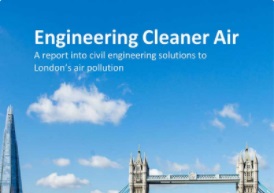Engineering Cleaner Air
In October 2017, the ICE London Air Quality Taskforce, led by the government’s former chief construction advisor Professor Peter Hansford, launched Engineering Cleaner Air – a plan to help clean up London’s polluted air.
The report calls for an increase in pedestrianised routes, and how this could be managed to ensure pollution does not simply spill over onto neighbouring streets.
It also highlights the use of new technologies to boost air quality, calling on London to become a world leader in electric vehicle usage and adopt new methods of monitoring air quality on the Underground.
The taskforce was set up to look at what civil engineers can do to help reduce London's poor air quality across transport, planning, water infrastructure, technology and industry practices.
To support these aims, the report calls for:
- Increased use of vehicle consolidation centres.
- More pedestrianised routes.
- Embed a zero emission approach to building planning.
- Make air quality improvements a central objective of the new Energy for Londoners agency.
- Promote good practice air quality planning policy in neighbourhood plans.
- Incentivise use of commercial wharves along the River Thames.
- London should become a world leading city in electric vehicle usage.
- Monitoring underground station air quality and ensure new stations contain air pollution reduction solutions.
- A Construction Logistics Plan should be produced as part of every development planning submission.
- The Considerate Constructors Scheme should give more weight to compliance with NRMM requirements as part of its monitoring and scoring system.
At the launch event the audience heard from a panel of speakers including Simon Birkett from the Campaign for Clean Air in London on the need to think ahead and what civil engineers can do now to tackle air quality issues.
Outlining the key points from the report, Heleni Pantelidou, Associate Director, Arup, highlighted the report's call to use new technologies to boost air quality, calling on London to become a world leader in electric vehicle usage and adopt new methods of monitoring air quality on the Underground.
There was general agreement that the industry as a whole had responded well on safety concerns but health aspects had been ignored.
The report has the backing of the Considerate Constructors Scheme. Chief Executive Edward Hardy announced plans to monitor air pollution at over 3,500 sites, companies and suppliers each year in the capital alone.
Commenting on the launch of the report, Professor Hansford said:
"Our 10 point plan to improve air quality in London presents clear and achievable targets.
"The civil engineering industry has a significant role to play in reducing air pollution, helping to improve air quality for all residents and visitors in London.
"Whilst our report focuses on London it can act as a blueprint for urban areas across the UK and around the world. This report should spur the action required by both policy makers and industry to make poor air quality an issue of the past."
This article was originally published here on 11th October 2017 by ICE. It was written by James Sloan.
--The Institution of Civil Engineers
[edit] Related articles on Designing Buildings Wiki
Featured articles and news
A change to adoptive architecture
Effects of global weather warming on architectural detailing, material choice and human interaction.
How big is the problem and what can we do to mitigate the effects?
Overheating guidance and tools for building designers
A number of cool guides to help with the heat.
The UK's Modern Industrial Strategy: A 10 year plan
Previous consultation criticism, current key elements and general support with some persisting reservations.
Building Safety Regulator reforms
New roles, new staff and a new fast track service pave the way for a single construction regulator.
Architectural Technologist CPDs and Communications
CIAT CPD… and how you can do it!
Cooling centres and cool spaces
Managing extreme heat in cities by directing the public to places for heat stress relief and water sources.
Winter gardens: A brief history and warm variations
Extending the season with glass in different forms and terms.
Restoring Great Yarmouth's Winter Gardens
Transforming one of the least sustainable constructions imaginable.
Construction Skills Mission Board launch sector drive
Newly formed government and industry collaboration set strategy for recruiting an additional 100,000 construction workers a year.
New Architects Code comes into effect in September 2025
ARB Architects Code of Conduct and Practice available with ongoing consultation regarding guidance.
Welsh Skills Body (Medr) launches ambitious plan
The new skills body brings together funding and regulation of tertiary education and research for the devolved nation.
Paul Gandy FCIOB announced as next CIOB President
Former Tilbury Douglas CEO takes helm.
UK Infrastructure: A 10 Year Strategy. In brief with reactions
With the National Infrastructure and Service Transformation Authority (NISTA).
Ebenezer Howard: inventor of the garden city. Book review.
Airtightness Topic Guide BSRIA TG 27/2025
Explaining the basics of airtightness, what it is, why it's important, when it's required and how it's carried out.
























Comments
The Institution of Civil Engineers managed to write a report about improving air quality in London with a lot of focus on electric vehicles and only a small mention of reducing motor traffic (freight vehicle consolidation centres) and omitting cycling from their main findings.
This is missing a point which has been made by government advisers and experts that switching to electric vehicles will not solve air pollution unless we have significant motor traffic reduction: https://www.theguardian.com/environment/2017/aug/04/fewer-cars-not-electric-cars-beat-air-pollution-says-top-uk-adviser-prof-frank-kelly
Electric vehicles have the same problems of tyre and brake dust as standard cars, which causes a significant amount of particulate pollution in London for which there is no safe limit.
Apparently the possibility of getting 10% of people on to vehicles with no emissions (bikes!), and where the health benefits directly address some of the problems caused by pollution, isn't worth mentioning. This seems to ignore the current mayor's Healthy Streets agenda and the work done by the previous mayor on cycling.